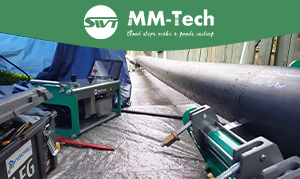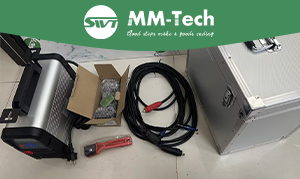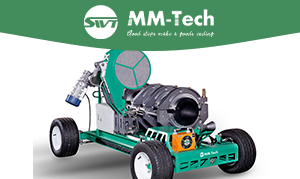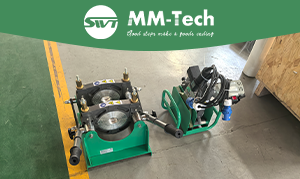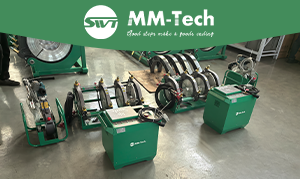Selecting the right welding equipment is important for HDPE sewage pipe jobs. The most used welding machines are butt fusion, electrofusion, and socket fusion types. Each welding machine works best for different uses with high-density polyethylene pipes. The welding equipment you pick affects how strong the pipes are. It also helps stop leaks and makes sure HDPE systems follow rules. MM-Tech is a top company with advanced welding machines for hdpe pipe welding. Their machines have exact controls that keep welds strong and pipes lasting longer.
Industry data shows that about 23% of HDPE pipe failures happen at the weld seam, so picking the right equipment is very important.
Welding Equipment Type | Description | Typical Application |
|---|---|---|
Butt Fusion Welding Machines | Heats and joins pipe ends for smooth joints | Big sewage and high-pressure projects |
Electrofusion Welding Machines | Uses electricity to melt resin at pipe joints | Hard fittings in sewage systems |
Socket Fusion Welding Machines | Heats and puts pipe into socket fittings | Small pipes in plumbing |
Key Takeaways
Picking the right welding equipment makes HDPE pipe joints strong. This helps stop leaks and keeps sewage systems working for a long time.
Butt fusion, electrofusion, and socket fusion machines work for different pipe sizes. They also fit different job needs to get the best results.
Using the right welding steps and good tools makes safe and strong joints. These joints meet what the industry needs.
Teaching workers to use welding machines the right way makes welds better. It also stops leaks or breaks that cost a lot to fix.
Checking and testing welds often finds problems early. This keeps sewage pipes safe and working well.
Importance of Welding Equipment for HDPE Pipes
Pipe Integrity and Leak Prevention
Welding equipment is very important for strong hdpe pipes. Using the right welding equipment makes joints strong like the pipe. Fusion methods, such as butt fusion, electrofusion, and socket fusion, make smooth connections. These joints do not have weak spots that leak. High-density polyethylene pipes joined with good welding equipment can take high pressure. They also work well in tough places. This lowers the chance of leaks and breaks in sewage pipes. The right welding equipment helps workers do careful work, even with tricky pipe shapes. Because of this, hdpe pipes last longer and need fewer repairs. Using the right welding equipment keeps sewage systems safe and working well.
Tip: Good fusion joints made with quality welding equipment stop leaks and save money on repairs later.
Standards and Safety
It is important to follow rules when welding hdpe pipes. Standards like ASTM and ISO give clear rules for welding high-density polyethylene pipes. These rules help make sure every weld is safe and good quality. Welding equipment that meets these rules helps workers trust their work. It also helps projects pass checks and avoid big mistakes. MM-Tech makes welding equipment that follows these rules. Their machines have exact controls and work well. MM-Tech also helps train workers so they use welding equipment safely and the right way. Picking certified welding equipment keeps workers and the environment safe. This focus on safety and rules helps every hdpe pipe project turn out better.
Main Types of HDPE Pipe Welding Equipment
Butt Fusion Machines (MM-Tech)
Butt fusion welding machines are important for joining hdpe pipes. These machines use heat to melt the ends of two pipes. The operator pushes the melted ends together to make a strong joint. MM-Tech’s butt fusion welding machines have special features. Each machine has a digital control panel and a Teflon-coated heating plate. This keeps the pipe from sticking and helps make a smooth weld. The machines work with pipe sizes from 50mm to 1200mm. Operators use the control panel to set the temperature between 210°C and 230°C. The temperature is very accurate, within ±1°C. This helps every weld meet strict rules.
MM-Tech’s butt fusion welding machines also have hydraulic clamping systems that follow ISO 12176-1. The machines can add a data logger to record welding details and help meet ASTM F3124 rules. These features make the machines good for long, straight runs of hdpe pipes in big sewage jobs. The strong build and easy-to-use design help workers get less tired and make the machine last longer. MM-Tech gives a 24-month warranty and worldwide support. This makes their butt fusion welding machines a trusted pick for workers.
Butt fusion is the most used way to join hdpe pipes in sewage jobs. It works best for long pipes and big sizes, making strong joints that last.
Model | Pipe Diameter Range (mm) | Pressure Adjustment Range (MPa) |
|---|---|---|
SHT160-SHY | 63 – 160 | 0 – 10 |
SHT200-SHY | 63 – 200 | 0 – 10 |
SHT250-SHY | 90 – 250 | 0 – 10 |
SHT315-SHY | 160 – 315 | 0 – 10 |
MM-Tech’s butt fusion welding machines mix automation, accuracy, and strength. They help make joints that last over 50 years, even in hard places. These machines are great for workers who need strong welding equipment for hdpe pipe fusion and welding jobs.
Electrofusion Welding Machines (MM-Tech)
Electrofusion welding machines join hdpe pipes in a different way. These machines use special fittings with electric wires inside. When the operator starts the machine, electricity heats the wires in the fitting. The heat melts the pipe and the fitting, joining them together. MM-Tech’s electrofusion welding machines have smart controls for steady voltage and timing. Each machine has a bright LCD screen, many language choices, and a USB port for saving data. Operators can use barcode scanning for smart fitting checks and GPS to track where welds are made.
Electrofusion welding machines are good for places with little space or hard-to-reach spots. Workers can carry these machines to steep hills, small areas, or places with lots of elbows and valves. The equipment lets workers control temperature and time, making it easier to get good joints outside. MM-Tech’s electrofusion welding machines also have safety features like auto shutdown and real-time checks. These features help make sure every weld is strong and does not leak.
Electrofusion is often best for tricky joints or when butt fusion machines cannot fit at the job.
Aspect | Electrofusion Welding | Butt Fusion Welding |
|---|---|---|
Process | Uses electric current to heat resistive elements in fittings to melt and fuse pipe ends | Heats pipe ends on a hot plate until molten, then presses them together |
Equipment | Requires specialized electrofusion welding machines and fittings with heating elements | Uses simpler equipment like heating plates and hydraulic clamps |
Pipe Compatibility | Suitable for joining pipes of different diameters and materials using compatible fittings | Limited to pipes of the same diameter and wall thickness |
Control & Automation | Allows precise control over temperature and time; can be automated for large projects | Manual control; generally faster but less automated |
Application Flexibility | Suitable for complex joint configurations and fittings | Not suitable for all fittings or complex joints |
Operator Skill | Requires trained personnel to operate specialized equipment | Requires skilled operators for proper heating, alignment, and pressure |
Cost | Higher initial equipment investment | More cost-effective equipment setup |
Field Use | Easier and higher quality in field conditions | Often better suited for factory settings due to equipment needs |
MM-Tech’s electrofusion welding machines help workers make strong joints that last many years. The equipment works with many pipe types and comes with a 24-month warranty. These machines are a smart pick for hdpe pipe welding in tough places.
Socket Fusion Tools
Socket fusion tools are used for joining small hdpe pipes. These machines heat the outside of the pipe and the inside of the fitting. The operator pushes the pipe into the fitting to make a smooth joint. Socket fusion tools work best for pipes up to 2 inches wide. The joints made with socket fusion tools are strong and do not leak, just like butt fusion joints.
Socket fusion tools are simple to use and keep hdpe pipes flexible. Workers use these machines in plumbing or when pipes are in tight spaces. The equipment makes joints that resist chemicals and pressure, so it is good for sewage pipes. But, socket fusion tools need trained workers and special equipment. The job can be hard in bad weather or small spaces.
Aspect | Advantages | Limitations |
|---|---|---|
Application Size | Socket fusion is commonly used for small-diameter pipes and fittings, typically up to 2 inches. | N/A |
Joint Strength | Creates strong, seamless joints with strength comparable to the parent material. | Requires specialized equipment and trained operators. |
Leak Resistance | Fusion joints are homogeneous and leak-proof, suitable for pressurized systems. | Initial investment in equipment and training can be high, less ideal for small-scale or occasional use. |
Chemical Resistance | Maintains HDPE’s chemical resistance, suitable for conveying corrosive or abrasive fluids. | Challenging to perform in adverse weather conditions (extreme temperatures, humidity, wind). |
Installation | Seamless joints reduce need for additional fittings, simplifying installation. | Limited access in confined spaces can complicate welding operations. |
Compatibility | Specifically designed for HDPE pipes and fittings, ensuring reliable performance. | Fusion welding is limited to HDPE material, not compatible with other pipe materials. |
Socket fusion tools help workers make good joints in small hdpe pipes. These machines are a good choice for plumbing and jobs where space is tight. Socket welding machines give an easy way to join hdpe pipes with results that last.
Tip: Picking the right welding equipment for each job helps keep every hdpe pipe fusion project safe and strong.
HDPE Pipe Fusion Process
Butt Fusion Steps
Butt fusion welding machines help join hdpe pipes for sewage. This process uses heat to make a strong joint. Operators follow these steps for good pipe fusion:
Clean the pipe ends to remove dirt. Line up the pipes for a tight fit.
Use a trimmer to make the pipe ends flat and smooth.
Heat the pipe ends with a welding machine. The heating plate is set between 400°F and 450°F.
Take away the heating plate. Press the melted pipe ends together with the hydraulic unit.
Hold the pipes still while they cool. This makes the joint hard and strong.
The table below lists the main steps for butt fusion welding:
Parameter | Description | Notes |
|---|---|---|
Welding Pressure | Force used on pipe ends | Changes with pipe size |
Total Pressure | Welding and drag pressure together | Adjusted for good welds |
Heat Soaking Time | Time pipe ends are heated after reaching the right heat | Wall thickness × 10 (sec) |
Cooling Time | Time for the joint to cool and get hard | Makes the joint strong |
MM-Tech’s butt fusion welding machines use exact controls and strong clamps. These features help keep pipes lined up. This helps workers make good joints every time.
Electrofusion Steps
Electrofusion welding machines join hdpe pipes with special fittings. First, workers clean and peel the pipe surface to remove old layers. Next, they put the pipe into the fitting. The welding machine sends electricity through wires inside the fitting. The wires get hot and melt the pipe and fitting. This joins them together. Clamps keep the pipes lined up during welding. The machine controls heat and time for a strong joint. Workers must let the joint cool before touching it. Using the right welding equipment and following instructions helps stop problems like bad joints or overheating.
Tip: Barcode scanning and automatic settings on MM-Tech welding machines help stop mistakes and make better welds.
Socket Fusion Steps
Socket fusion tools join small hdpe pipes using heat. Workers clean the pipe and fitting first. The welding machine heats the outside of the pipe and the inside of the fitting at the same time. When hot, the worker pushes the pipe into the fitting to the right depth. Holding the joint still while it cools makes it strong. After cooling, workers check the joint for any problems. MM-Tech socket fusion tools give even heating and are easy to use. This makes them good for jobs that need the same results every time.
Supporting Tools and Operator Skill
Preparation Tools and Accessories
Workers need special tools to make strong joints in HDPE pipes. Good tools help stop leaks and keep the pipes safe. Each tool does something important during welding. The table below lists these tools and why they are needed:
Preparation Tools and Accessories | Purpose and Importance |
|---|---|
Pipe Cutting Tools and Debeaders | Make pipe ends flat and smooth for strong welds |
Pipe Scrapers and Cleaning Tools | Clean off dirt and grease so pipes join well |
Clamps | Hold pipes still so they line up right |
Pipe Roller Supports | Help move pipes into place for welding |
Squeeze Tools | Press pipes together where needed |
Test Pumps | Check if joints are strong by testing with pressure |
Welding Machines with Digital Controls | Set heat, pressure, and time for good welds |
Data Logging Features | Save welding details for checking quality |
Portable Power Sources | Give power when working far from outlets |
Safety Equipment and Protocols | Keep workers safe and stop bad welds from unsafe actions |
Getting pipes ready and following each welding step makes joints very strong. Sometimes, the weld is even stronger than the pipe itself. Using the right tools and steps lowers the chance of leaks or weak spots. If workers skip steps or use wrong settings, the weld can break or leak.
Operator Training and Certification
Trained workers are very important for good HDPE welding. Rules say only trained and certified people should use welding machines. These workers must know how to set the machine and control heat and pressure. They also need to follow safety rules and write down each weld for checks.
MM-Tech helps workers by making certified welding machines that meet ISO and CE rules. Their machines have screens, automatic controls, and safety parts. These things help workers do each step right and keep welds strong. MM-Tech also lets workers save weld data and use USB to move records, so it is easy to check weld quality.
Training and good welding machines help workers make safe, strong joints in HDPE pipes. This keeps sewage pipes working well for a long time.
Ensuring Quality in HDPE Pipe Welding
Inspection and Testing
Quality checks make sure hdpe welding joints stay strong and safe. Workers use different ways to check and test welds in sewage pipe jobs:
Destructive Weld Testing: Workers cut out a small piece of pipe with a weld. They use hydraulic tools to bend or crush it. This test shows if the weld can handle stress.
Hydrostatic Pressure Testing: Workers fill the pipe with water and raise the pressure higher than normal. They keep this pressure for up to three hours. If the pressure drops or water leaks, there may be a problem with the weld.
Visual Inspection: Workers look at the joints for leaks or problems, especially after pressure tests.
Leakage Testing: For pipes that do not carry pressure, workers use air, vacuum, or water to check for leaks.
Digital Radiography: This X-ray method finds hidden weld problems, like cracks or holes, that eyes cannot see. It gives clear pictures and helps find issues early.
Tip: Holding pipes in place during pressure tests stops them from moving or getting damaged.
Common weld problems are pipes not lined up, dirt in the weld, or cracks. Most problems happen at the joints. Digital radiography helps find these problems before the pipes are used.
Compliance and Best Practices
Following rules keeps hdpe welding jobs safe and reliable. Best ways to work include:
Marking all hdpe fittings with maker, size, and date for easy tracking.
Cleaning welding surfaces with special cleaners and lint-free wipes.
Using automatic welding equipment to lower mistakes.
Keeping a checklist for quality control, checking size, weight, color, and on-site tests.
Recording weld data with barcodes and saving it in a database for tracking.
Checking that suppliers follow rules like ISO 4427 or ISO 4437.
Following safety rules when handling and installing hdpe pipes.
MM-Tech supports these best ways to work. The company tests every welding machine before sending it out. Each machine has a two-year warranty. MM-Tech uses strict quality checks and has a skilled team for help. Their welding equipment meets export rules and helps workers make strong, safe welds every time.
Picking the right welding equipment for hdpe sewage pipes makes the system strong and stops leaks. MM-Tech gives good machines that help pipes last a long time. It is important to use machines that work well and are kept in good shape. Workers must clean pipe surfaces and make sure they are flat. They also need to control heat and pressure carefully. Checking machines often and teaching workers how to use them helps the pipes work better. MM-Tech has welding machines and gives help to workers on any hdpe pipe job.
Always use fusion equipment that is high quality and checked.
Make sure pipe surfaces are clean and flat.
Teach workers to find and fix problems.
FAQ
What is the main difference between butt fusion and electrofusion welding?
Butt fusion joins pipes by heating their ends and pressing them together. Electrofusion uses fittings with wires inside that heat up and melt the pipes. Both ways make strong joints that do not leak in HDPE pipes.
How does MM-Tech ensure the quality of its welding machines?
MM-Tech checks each welding machine before sending it out. The company follows ISO and CE rules for safety and quality. Every machine has a warranty. MM-Tech also gives help and training to workers.
Can one person operate an MM-Tech butt fusion machine?
Yes, one trained worker can use an MM-Tech butt fusion machine. The machine has digital controls and a hydraulic system to make things easy. Training helps the worker use the machine the right way.
Why is operator training important for HDPE pipe welding?
Training teaches workers how to set up the machine and control heat and pressure. It also shows them how to stay safe. Trained workers make better joints and help stop leaks or breaks.
What should workers do if a weld fails inspection?
Workers need to cut out the bad joint and weld a new one. They should check the pipe ends for dirt or damage before starting again. Using the right settings and following steps helps stop more problems.


